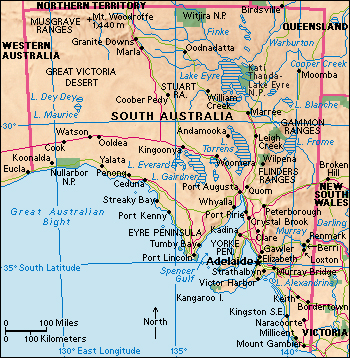Kangaroo Island is the largest island off the coast of South Australia. It is 90 miles (145 kilometers) long and 27 miles (44 kilometers) wide at its widest point. It has an area of 1,660 square miles (4,300 square kilometers) and is the third largest island in Australian waters. The island is about 90 miles (145 kilometers) south of Adelaide. It is separated from the mainland by Investigator Strait.

Most of the people on the island work as farmers, growing wheat, barley, and oats, and raising sheep and cattle. Other industries include fishing and the production of honey, yacca gum, eucalyptus oil, salt, and gypsum.
Tourism is one of the main sources of income on the island. The island’s largest national park is Flinders Chase. Tourists can see fairy penguins and enjoy the rugged natural coastline. The island is linked to Adelaide by a regular air service. The main towns are Kingscote, Parndana, and Penneshaw.
The British explorer Matthew Flinders discovered the island in 1802 and named it in gratitude for the large number of kangaroos his men killed for food. The French explorer Nicolas Baudin sailed around the island in 1803. Before 1836, there was no official settlement in the area.
The first settlers of South Australia arrived aboard the Duke of York in July 1836. They landed at Nepean Bay on Kangaroo Island. They established a temporary depot and whaling station under the supervision of Samuel Stephens, first manager of the South Australian Company. The settlers brought sheep, poultry, cattle, and goats. The settlement was named Kingscote after Henry Kingscote, then director of the South Australian Company.
In late 2019 and early 2020, Kangaroo Island was devastated by bushfires. More than 800 square miles (2,070 square kilometers) of land burned, killing thousands of animals and destroying many homes and farms.
